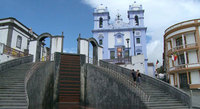The Azores - what you need to know

All the nine islands of the Azores Archipelago are of volcanic origin with the island of Flores marking the westernmost border of the European continent. 244,780 people live in the 2,325 sq. of this island territory, which is part of the Portuguese state and constitutes the Autonomous Region of the Azores.
The islands of the archipelago are divided in three geographical groups: the Eastern Group, comprising Santa Maria and São Miguel, the Central Group, including Terceira, Graciosa, São Jorge, Pico and Faial, and the Western Group, composed by Corvo and Flores. The Azores, along with the archipelagos of Madeira, Canary Islands and Cape Verde, constitute the biogeographic region of Macaronesia, a name which means "fortunate islands".
Nine islands sculptured by nature lying in the Atlantic ocean
Brought together in an archipelago, each Azorean island has its own identity. Even if they all share an extraordinary natural legacy, they also have their own landscape, traditions, cuisine and architecture. They have been sculptured by ancient volcanoes and populated over the centuries by courageous and kind people. Thus the Azores are a place of varied experiences and emotions.
Climate
The climate of the Azores is mild. During the winter, strong winds stir the sea and purify the air. The average temperature remains at a generous 14º C, which does not prevent snow from falling on the summit of the mountain of Pico, given its altitude (2,350m). The rainy periods, although frequent, are generally short. The summer is warm and sunny, with temperatures staying around 24º C. The sea water remains at an inviting temperature, between 17º C and 23º C.
History
In the realm of legend, some associate the Azores to the Atlantis, the mythical island kingdom quoted by Plato. As for history, references to nine islands in the Atlantic Ocean located approximately in the position of the Azores can be found in books and maps since the 14th century. However, it was the Portuguese Maritime Discoveries, led by Prince Infante D. Henrique, that the Azores were definitely registered in the map of Europe. It is unknown whether the first navigator to reach the archipelago was Diogo de Silves in 1427 or Gonçalo Velho Cabral in 1431. The origin of the name Azores is also debatable as there are various theories. The most common associates the designation of the common buzzards found on the islands which were mistaken as being another bird of prey: the northern goshawk (açor). What is now certain is that it was Prince Infante D. Henrique who instigated the settlement of the islands. First, animals were sent, between 1431 and 1432, and later settlers started to arrive from 1439.
From that date, the settlement continued throughout the 15th century (Western and Central Groups) and the 16th century (Western Group). Jews, Moors, Flemish, Genovese, Englishmen, Frenchmen, and African slaves came together with the Portuguese from the mainland to face the hardships of such a task.
This epic start moulded a people that throughout the centuries was able to resist volcanic eruptions, isolation, invasions of pirates, political wars and infesting diseases. The courage of the Azorean people was confirmed when they resisted the Spanish domination during the succession crisis of 1580, and when they supported the liberal movement during the civil war (1828-1834). During the 20th century, this bravery was once again evident during the whale hunting era, when the men would go to sea in small, wooden boats ready to confront, in the endless blue sea, giant sperm whales.

